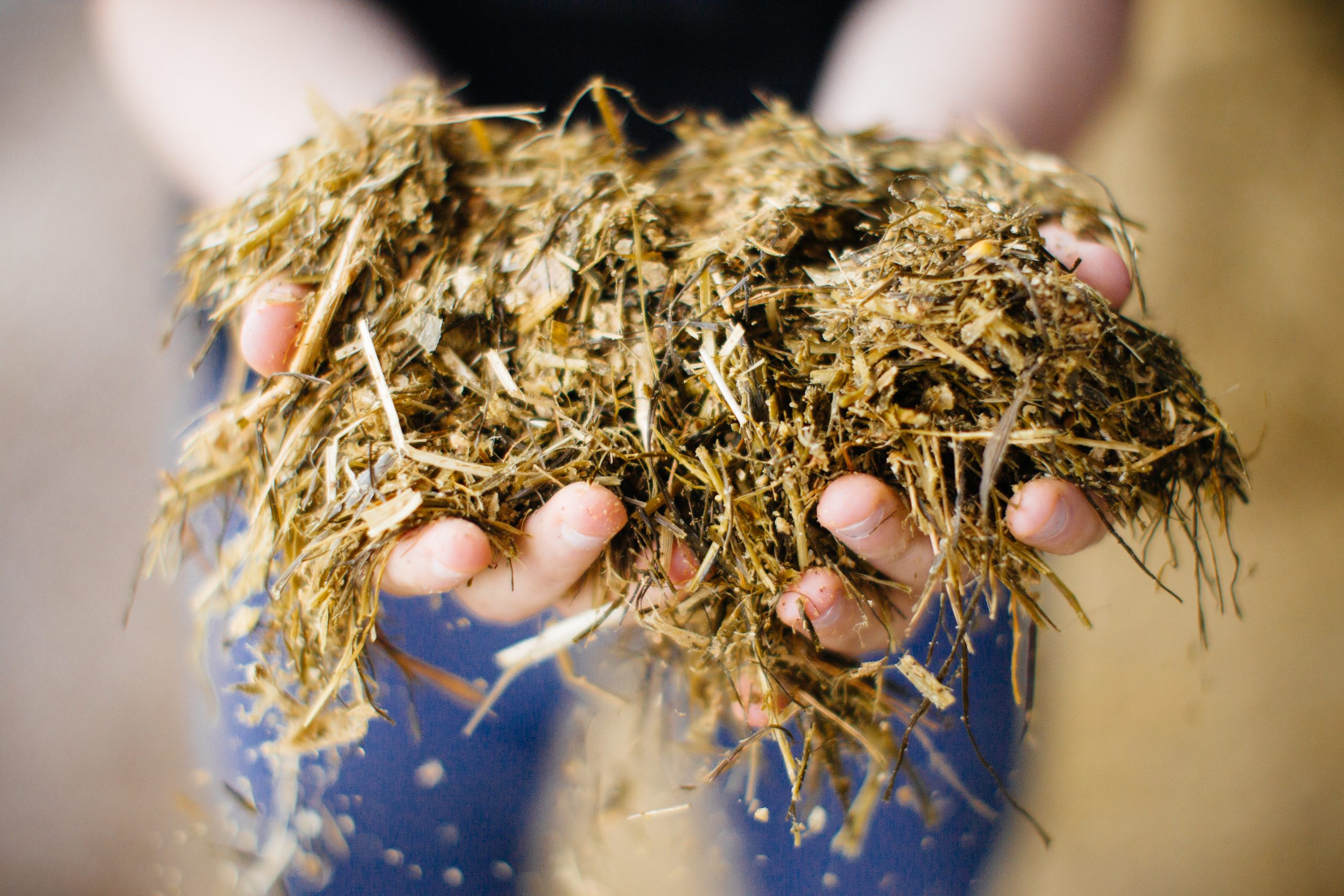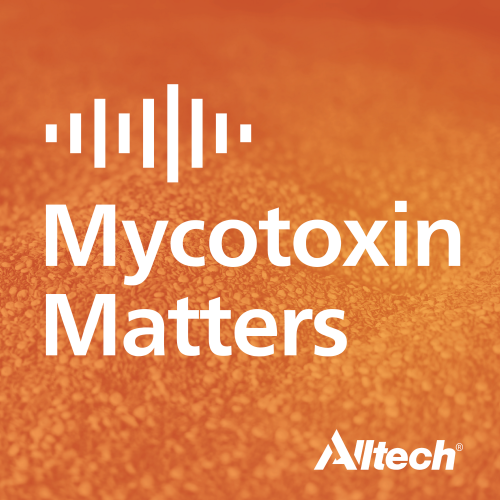Keep ahead of the threat
Stay up to date with the latest mycotoxin information by signing up to our newsletter

Managing the Mycotoxin Challenge in Forages
Author: Dr. Max Hawkins: PhD, Global technical support, Alltech® Mycotoxin Management
Click below to listen to the Mycotoxin Matters podcast episode with Dr. Max Hawkins hosted by Nick Adams. You can also hear the full audio or listen to the episode on Apple Podcasts or Spotify. You can find an edited transcript at the bottom of the page.
*The following article has been published in IDT May 2021. Please click here to view.
The primary molds and mycotoxins impacting forages
Forages have long been the standard feedstuff for ruminant livestock production. The use of higher forage content total mixed ration (TMR) has increased in recent years, createing the need for greater monitoring of the quality for high inclusion feedstuff(s). Major forage crops include corn silage, grass silages and haylages, and small grain silages. These individually and in combination will represent the greatest percentage of the TMR and their quality will be a determining factor in efficient production and animal health.
Forage crop quality can be greatly influenced by weather stresses. These stresses can include drought, excess moisture, wind, hail, and combinations of these factors. The stress will make the plant more susceptible to mold infestation. These soil-borne molds include Aspergillus, Fusarium and Penicilliums that can produce secondary metabolites called mycotoxins. In addition to the challenge posed by these individual mycotoxin types, there are also potential to additive and synergistic toxin effects to be considered. The associated environmental stresses and some of the mycotoxins produced from these molds are,
- Aspergillus – warm and dry environment – Aflatoxin, gliotoxin, sterigmatocystin and verruculogen
- Fusarium – moderate temperature and moist – Trichothecenes, fusaric Acid, emerging mycotoxins, fumonisin andzZearalenone
- Penicillium – drier, less densely packed forage clamps that allows oxygen penetration – Mycophenolic Acid, penicillic acid, roquerfortine C and patulin
Factors influencing mycotoxin production
The climatic factors that can affect forage quality and mycotoxins may range from a high impact incident in a day or two to longer term seasonal effects. The timing of these events in terms of plant maturity is important as to which mycotoxin(s) may be produced. Most of this in relation to pre and post flowering and pollination. This critical phase is also when the plant is susceptible to climatic, disease and insect challenges that can further increase plant damage and and subsequent mold infestation and mycotoxin challenges. Crucial to the success of a mycotoxin management program is effective mycotoxin analysis. Identifying multiple mycotoxin contamination, using tests such as Alltech 37+®is a more accurate risk assessment of feeds. However, producers should not discount the value of a rapid mycotoxins test such as Alltech RAPIREAD®, that can provide results in just minutes for individual mycotoxins. The sample itself must be collected while considering the amount of variation in the total inventory. It has been shown that (Gallo, 2016) (Borreani, 2010) silage cannot be considered a homogeneous mixture due to variation within a field, plant maturity and dry matter, time to harvest and fill, delays due to weather and breakdowns, and filling and packing methods. Therefore, it is important to utilize multiple samples from throughout the silage pile to build a pooled sample that attempts to develop a homogenous sample of the available inventory.
The mycotoxin impact on ruminant animals
The greatest mycotoxin challenge in corn silage typically derives from the Fusarium mold, while the most prominent mycotoxins are type B trichothecenes, fumonisin, fusaric acid and emerging mycotoxins. In Alltech’s 2020 North American Summer Harvest Survey (figure 1), almost 95% of the 288 samples analysed contained fusaric acid, over 80% contained type B trichothecenes and over 70% of samples were contaminated with emerging mycotoxins. These mycotoxins in feeds can lead to issues with dry matter intake, milk production, average daily gain (ADG), digestion, gut health, liver function, respiratory health, conception rate, liver function and immune response. Mycotoxins can be present at high risk levels at harvest, and the trend is that they can increase over time in storage. The exact nature of this increase in risk is dependent on the individual situation. Vandicke et al (2021) suggested that some field produced mycotoxins may be reduced during storage but, if silages are poorly made, this effect is lost through the production of storage mycotoxins, increasing the overall risk, a trend that has been seen in recent years based on submissions to the Alltech 37+ laboratory. Corn silage data collected in Alltech’s US Harvest Analysis over a three-year period, 2018-2020, shows an increase in Fusarium mycotoxins over time from harvest until winter and spring feed out. Deoxynivalenol, one of the most occurring mycotoxins, has a consistent increase year after year during this period.
There are some key steps in the management of forage during harvest and ensiling which producers can take to minimize this risk, including ensiling forages between 32 – 36% dry matter content, tightly packing and sealing the clamp, and proper clamp face management during feed out to minimize oxygen penetration.
Penicillium can present a major challenge in grass silage and haylages. Penicilliums are normally viewed as storage mycotoxins, and dry, poorly packed silages and haylages can allow greater oxygen penetration providing the conditions for micro-aerobic mold to flourish. The levels of Penicilliums can increase greatly from harvest through feed out. Small grain silages can have an array of mycotoxins present but typically Fusarium and Penicilliums are the most occurring. Zearalenone tends to be more present in cooler and wetter growing seasons with subsequent negative effects reproduction performance when ingested by animals.

Fig 1. Mycotoxin occurrence in samples analysed during Alltech 2020 North American Summer Harvest Survey.

Fig 2. Key results from Alltech 2020 North America Summer Harvest Survey
The actual mycotoxin risk can range from low to high, and can be the result of 1 individual mycotoxin at a lower or higher risk, or multiple mycotoxins that can generate additive and/or synergistic interactions. The multi mycotoxin challenge is demonstrated in figure 2. An effective mycotoxin control program must be able to manage all situations. A higher risk situation was studied (Santos, Fink-Gremmels, 2014) across 3 separate dairy farms. In this study, a multiple mycotoxin challengeresulted in decreased milk production and increased somatic cell count (SCC) across all 3 farms. When a glucomannan mycotoxin adsorbent (GMA) was added to the diet, milk production increased by 6.1 kg/cow/day, SCC decreased by 62% and trolox equivalent antioxidant capacity (TEAC) was improved over an 8-week period. Lower risk challenges are often considered as nonchallenging to cow health and performance. (Hulik, 2014) demonstrated that multiple mycotoxins at low risk did not significantly impact milk production, however, when a GMA was included in the control program, the pregnancy rate was improved by 19.3%.
Mitigating the mycotoxin threat
The climate impact on crop quality and subsequent mycotoxin contamination poses a continuous risk to healthy and efficient ruminant production. This mycotoxin risk can be further increased by harvest and storage conditions that are less than ideal.
Although mycotoxins are an unavoidable problem, some key management practices can help reduce the risk attached to forages and ruminant feeds. Alltech believes that effective mycotoxin management is about seeing the whole challenge, from the farm to the feed mill and from risk assessment to feed management. To effectively manage the inevitability of feed mycotoxin contamination, it is crucial to understand the level of mycotoxin challenges so that the right steps can be taken to mitigate any adverse effects on animal performance, production efficiency and food safety. Using a combination of modern management tools, the Alltech® Mycotoxin Management Program provides a complete holistic solution to help producers take control of mycotoxin contamination and protect their businesses. The program is built around next-generation risk identification technology, data analysis and insights and mycotoxin binder solutions designed to reduce the damaging effects of mycotoxins on animal health and production potential.








